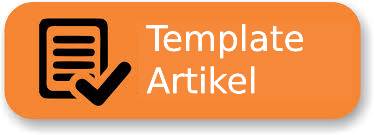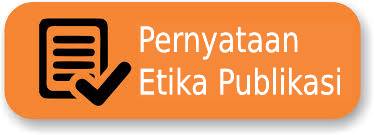Author Guide Line
GUIDELINES FOR AUTHOR
Manuscript Components
Research result article consists of a title, author's name, abstract in English, keywords, introductions, methods, results, discussions, conclusions and recommendations, and bibliography.
Review article consists of a title, authors name, abstract in English, keywords, introductions, contents, closings, and bibliography.
WRITING GUIDE
Title
- The title is written in English language and informative, concise, and not too long or short (5 -12 word).
- Consists of the variables under study and describes the content of the manuscript.
- The title does not contain abbreviations or formulas.
- The title page should include the title of the manuscript only. The names of authors should be deleted to ensure double blinding of the paper during the peer review process.
Abstract and Keyword
- The abstract is concisely written, about the most important ideas and contain the problems or research objectives, research method, and research results.
- Written in Indonesian and English language with 150-250 words maximum.
- Keywords contain main words consisting of 3-5 words
Introduction
The introduction is presented in an integrated manner without subtitle. It is written in the form of paragraphs with a length of 15-20% the length of the article and contains:
- Background or research rational
- Theoretical basis
- Gap analysis
- State of art
- Research objective
Method
The method is written with a length of 15-20% the length of the articles and contain:
- The study design
- Data collection techniques and data sources
- Method of data analysis
- Write in full the location of the study, number of respondents, how to process the results of observations or interviews or questionnaires, how to measure performance benchmarks
Results and Discussion
Results and discussion are presented with a length of 60-70% the length of the articles. The results represent a major part of scientific articles containing:
- Results of data analysis
- Results of hypothesis testing
- It can be presented with a table or graph to clarify results verbally
- A discussion is an important part of the entire scientific article. The purposes of the discussion are: answer the research problem, interpret the findings, integrate the findings of research into the existing knowledge, and formulate a new theory or modify the existing theories (what/how, why, what else)
- The serial number that is used is number (1), (2), (3), and so on, do not need to use a composite number. Hyphens should not change the serial number.
Closings
- Contain conclusions and recommendations.
- Conclusions contain answers to the research questions
- Recommendations refer to the results of research and practical form of action, specify to whom and for what recommendation intended.
- Written in essay form, not in numerical form.
Bibliography
- Contain literature that is referenced in the content, arranged alphabetically, and written in the format American Psychological Association (APA) 6th Edition.
- Fully written, appropriate with the references in the content
- Only load literature referenced in the content
- Source of references are 80% from literature published last 10 years.
- References are at least 80% from research articles in journals or research reports.
- The article should refer to the article published in the Jurnal Genta Kebidanan
- Management reference application such as Mendeley, Zotero or Endnote, should be used by authors when citing a reference.
Submission Preparation Checklist
As part of the submission process, authors are required to check off their submission's compliance with all of the following items, and submissions may be returned to authors that do not adhere to these guidelines.
- The submission has not been previously published.
- Ensure the originality of the study by attaching a letter of the authenticity of research.
- Where available, URLs for the references have been provided.
- The text is single-spaced; uses a 12-point font; employs italics, rather than underlining (except with URL addresses); and all illustrations, figures, and tables are placed within the text at the appropriate points, rather than at the end.
- The text adheres to the stylistic and bibliographic requirements outlined in the Author Guidelines, which is found in About the Journal. The author uses the reference manager like a Mendeley, Endnote or Zotero.
Plagiarism screening will be conducted by the journal editor board using plagiarism checker services by Turnitin.
- If submitting to a peer-reviewed section of the journal, the instructions in Ensuring a Blind Review have been followed.
Copyright Notice
Click Copyright Transfer Agreement
Privacy Statement
The names and email addresses entered in this journal site will be used exclusively for the stated purposes of this journal and will not be made available for any other purpose or to any other party.












